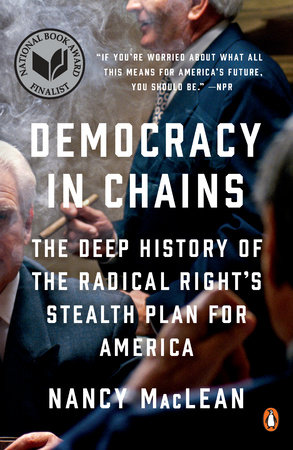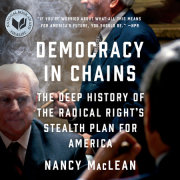INTRODUCTION
A QUIET DEAL IN DIXIE
As 1956 drew to a close, Colgate Whitehead Darden Jr., the president of the University of Virginia, feared for the future of his beloved state. The previous year, the U.S. Supreme Court had issued its second
Brown v. Board of Education ruling, calling for the dismantling of segregation in public schools with “all deliberate speed.” In Virginia, outraged state officials responded with legislation to force the closure of any school that planned to comply. Some extremists called for ending public education entirely. Darden, who earlier in his career had been the governor, could barely stand to contemplate the damage such a rash move would inflict. Even the name of this plan, “massive resistance,” made his gentlemanly Virginia sound like Mississippi.
On his desk was a proposal, written by the man he had recently appointed chair of the economics department at UVA. Thirty-seven-year-old James McGill Buchanan liked to call himself a Tennessee country boy. But Darden knew better. No less a figure than Milton Friedman had extolled Buchanan’s potential. As Darden reviewed the document, he might have wondered if the newly hired economist had read his mind. For without mentioning the crisis at hand, Buchanan’s proposal put in writing what Darden was thinking: Virginia needed to find a better way to deal with the incursion on states’ rights represented by
Brown.
To most Americans living in the North,
Brown was a ruling to end segregated schools—nothing more, nothing less. And Virginia’s response was about race. But to men like Darden and Buchanan, two w ell-educated sons of the South who were deeply committed to its model of political economy,
Brown boded a sea change on much more.
At a minimum, the federal courts could no longer be counted on to defer reflexively to states’ rights arguments. More concerning was the likelihood that the high court would be more willing to intervene when presented with compelling evidence that a state action was in violation of the Fourteenth Amendment’s guarantee of “equal protection” under the law. States’ rights, in effect, were yielding in preeminence to individual rights. It was not difficult for either Darden or Buchanan to imagine how a court might now rule if presented with evidence of the state of Virginia’s archaic labor relations, its measures to suppress voting, or its efforts to buttress the power of reactionary rural whites by underrepresenting the moderate voters of the cities and suburbs of Northern Virginia. Federal meddling could rise to levels once unimaginable.
James McGill Buchanan was not a member of the Virginia elite. Nor is there any explicit evidence to suggest that for a white southerner of his day, he was uniquely racist or insensitive to the concept of equal treatment. And yet, somehow, all he saw in the
Brown decision was coercion. And not just in the abstract. What the court ruling represented to him was personal.
Northern liberals—the very people who looked down upon southern whites like him, he was sure—were now going to tell his people how to run their society. And to add insult to injury, he and people like him with property were no doubt going to be taxed more to pay for all the improvements that were now deemed necessary and proper for the state to make. What about his rights? Where did the federal government get the authority to engineer society to its liking and then send him and those like him the bill? Who represented their interests in all of this?
I can fight this, he concluded.
I want to fight this.
Find the resources, he proposed to Darden,
for me to create a new center on the campus of the University of Virginia, and I will use this center to create a new school of political economy and social philosophy. It would be an academic center, rigorously so, but one with a quiet political agenda: to defeat the “perverted form” of liberalism that sought to destroy their way of life, “a social order,” as he described it, “built on individual liberty,” a term with its own coded meaning but one that Darden surely understood. The center, Buchanan promised, would train “a line of new thinkers” in how to argue against those seeking to impose an “increasing role of government in economic and social life.”
He could win this war, and he would do it with ideas.
While it is hard for most of us today to imagine how Buchanan or Darden or any other reasonable, rational human being saw the racially segregated Virginia of the 1950s as a society built on “the rights of the individual,” no matter how that term was defined, it is not hard to see why the
Brown decision created a sense of grave risk among those who did. Buchanan fully understood the scale of the challenge he was undertaking and promised no immediate results. But he made clear that he would devote himself passionately to this cause.
Some may argue that while Darden fulfilled his part—he found the money to establish this center—he never got much in return. Buchanan’s team had no discernible success in decreasing the federal government’s pressure on the South all the way through the 1960s and ’70s. But take a longer view—follow the story forward to the second decade of the twenty- first c entury—and a different picture emerges, one that is both a testament to Buchanan’s intellectual powers and, at the same time, the utterly chilling story of the ideological origins of the single most powerful and least understood threat to democracy today: the attempt by the billionaire- backed radical right to undo democratic governance.
For what becomes clear as the story moves forward decade by decade is that a quest that began as a quiet attempt to prevent the state of Virginia from having to meet national democratic standards of fair treatment and equal protection under the law would, some sixty years later, become the veritable opposite of itself: a stealth bid to r everse-engineer all of America, at both the state and the national levels, back to the political economy and oligarchic governance of midcentury Virginia, minus the segregation.
Alas, it wasn’t until the early 2010s that the rest of us began to sense that something extraordinarily troubling had somehow entered American politics. All anyone was really sure of was that every so often, but with growing frequency and in far-flung locations, an action would be taken by governmental figures on the radical right that went well beyond typical party politics, beyond even the extreme partisanship that has marked the United States over the past few decades. These actions seemed intended in one way or another to reduce the authority and reach of government or to diminish the power and standing of those calling on government to protect their rights or to provide for them in one way or another.
Some pointed to what happened in Wisconsin in 2011. The newly elected governor, Scott Walker, put forth legislation to strip public employees of nearly all their collective bargaining rights, by way of a series of new rules aimed at decimating their membership. These rules were more devilishly lethal in their cumulative impact than anything the antiunion cause had theretofore produced. What also troubled many people was that these unions had already expressed a readiness to make concessions to help the state solve its financial troubles. Why respond with a ll-out war?
Over in New Jersey, where Governor Chris Christie started attacking teachers in startlingly vitriolic terms, one headline captured the same sense of bewilderment among those targeted: “Teachers Wonder, Why the Heapings of Scorn?” Why indeed?
Equally mysterious were the moves by several GOP-controlled state legislatures to inflict fl esh-wounding cuts in public education, while rushing through laws to enable unregulated charter schools and provide tax subsidies for private education. In Wisconsin, North Carolina, Louisiana, Mississippi, and Iowa, these same G OP-controlled legislatures also took aim at state universities and colleges, which had long been integral components of state economic development efforts—and bipartisan sources of pride. Chancellors who dared to resist their agenda were summarily removed.
Then came a surge of synchronized proposals to suppress voter turnout. In 2011 and 2012, legislators in f orty-one states introduced more than 180 bills to restrict who could vote and how. Most of these bills seemed aimed at low-income voters, particularly minority voters, and at young people and the less mobile elderly. As one investigation put it, “the country hadn’t seen anything like it since the end of Reconstruction, when every southern state placed severe limits on the franchise.”
The movement went national with its all-out campaign to defeat the Obama administration’s Affordable Care Act. Hoping to achieve consensus, the White House had worked from a plan suggested by a conservative think tank and tested by Republican Mitt Romney when he was governor of Massachusetts. Yet when the plan was presented to Congress, opponents on the right almost immediately denounced it as “socialism.” When they could not prevent its passage, they shut down the government for sixteen days in 2013 in an attempt to defund it.
Numerous independent observers described such stonewalling, vicious partisanship, and attempts to bring the normal functioning of government to a halt as “unprecedented.” When the Republicans would not agree to conduct hearings to consider the president’s nominee to fill the Supreme Court seat left vacant after Justice Antonin Scalia died in early 2016, even the usually reticent Supreme Court justice Clarence Thomas spoke out. “At some point,” he told the Heritage Foundation, a conservative think tank, “we are going to have to recognize that we are destroying our institutions.”
But what if the goal of all these actions
was to destroy our institutions, or at least change them so radically that they became shadows of their former selves?
Many people tried to get a better handle on what exactly was driving this sortie from the right. For example, William Cronon, a University of Wisconsin historian and the incoming president of the American Historical Association, did some digging after Governor Walker’s attack on public employee unions in Wisconsin. His investigations convinced him that what had happened in Wisconsin did not begin in the state. “What we’ve witnessed,” he said, is part of a “ well-planned and well-coordinated
national campaign” (italics added). Presciently, he suggested that others look into the funding and activities of a then little-known organization that referred to itself as the American Legislative Exchange Council (ALEC) and kept its elected members a secret from outsiders. It was producing hundreds of “model laws” each year for Republican legislators to bring home to enact in their states—and nearly 20 percent were going through. Alongside laws to devastate labor unions were others that would rewrite tax codes, undo environmental protections, privatize many public resources, and require police to take action against undocumented immigrants. What was going on?
In 2010, the brilliant investigative journalist Jane Mayer alerted Americans to the fact that two billionaire brothers, Charles and David Koch, had poured more than a hundred million dollars into a “war against Obama.” She went on to research and document how the Kochs and other rich r ight-wing donors were providing vast quantities of “dark money” (political spending that, by law, had become untraceable) to groups and candidates whose missions, if successful, would hobble unions, limit voting, deregulate corporations, shift taxes to the less well-off, and even deny climate change. But still missing from this exquisitely detailed examination of the money trail was any clear sense of the master plan behind all these assaults, some sense of when and why this cause started, what defined victory, and, most of all, where that victory would leave the rest of us.
In an attempt to find that master plan, to understand whose ideas were guiding this militant new approach, others attempted to link what was happening to the ideas of the celebrity intellectuals of the so-called neoliberal right (neoliberal because they identify with the eighteenth- and nineteenth-century pro-market liberalism of thinkers such as Adam Smith)—especially such avid promoters as Milton Friedman, Ayn Rand, and Friedrich A. Hayek.9 But such inquiries ran aground, because none of the usual suspects had sired this campaign. The missing piece of the puzzle was James McGill Buchanan.
This, then, is the true origin story of today’s well-heeled radical right, told through the intellectual arguments, goals, and actions of the man without whom this movement would represent yet another dead-end fantasy of the far right, incapable of doing serious damage to American society.
Copyright © 2017 by Nancy MacLean. All rights reserved. No part of this excerpt may be reproduced or reprinted without permission in writing from the publisher.





